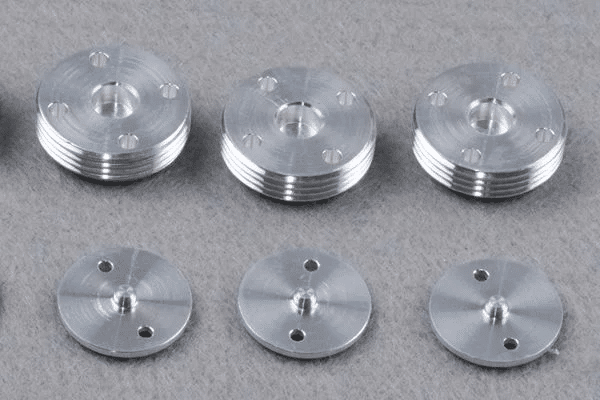Aluminum, with its lightweight and corrosion resistance, among other favorable properties, is one of the most common metals for part fabrication. Machinists and OEMs frequently apply some surface finishing and treatments to enhance these properties. Alodine coating is one such surface treatment to enhance CNC aluminum parts.
Alodine coating is a chemical process that coats the surface of aluminum parts with a protective layer made of chromate compounds. It is a type of chromate conversion coating that passivates aluminum and other compatible metals from external agents like corrosives. Besides its protective functions, Alodine coating helps to enhance the part’s aesthetics and improve paint adhesion, electrical conductivity, and durability.
This article discusses what you need to understand about Alodine coating as an aluminum metal finish. Therefore, before using it for your parts, you need to read ahead to understand its functions and applications. We also made a concise but detailed comparison of the surface treatment with similar finishes.
Benefits of Alodine Coating Aluminum
●Improve Corrosion Resistance
Indeed, aluminum is known for its innate corrosion resistance. However, exposure to harsh environmental conditions often diminishes this resistance, making the metal more susceptible to corrosion. Therefore, a suitable surface treatment that will enhance the metal’s defense against corrosives is needed.
Alodine coating serves as an additional external barrier, protecting the aluminum alloy. It forms a thin layer of chromate conversion coating that shields the metal against the penetration of moisture, chemicals, and other potential corrosives. Enhanced corrosion is essential for prolonging the lifespan of the aluminum material, making the metal more reliable for harsh environments like aerospace applications.
●Enhance Paint Adhesion
Painting is also a suitable surface finish for enhancing the mechanical features of CNC aluminum parts. However, there may be issues with paint adhesion and longevity of the paint finish. Therefore, initial treatment of the aluminum surface with a finish such as Alodine coating may prove effective for enhancing the paint adhesion property of the metal, increasing its durability. Consequently, Alodine-coated aluminum surfaces will adhere more effectively to paints, improving the overall aesthetics of the part while also increasing the protective properties that will last for a long time.
●Enhance Electrical Conductivity
This advantage of Alodine coating aluminum parts is more important for electrical applications. Some surface finishing coats metal surfaces by creating an insulating layer on the metal, impeding electrical flow. However, Alodine coating maintains the inherent conductive property of the aluminum metal while also enhancing its mechanical properties for increased durability. The combination of these functions makes Alodine-coated aluminum an excellent choice for electrical fittings and components that require adequate conductive properties.
Alodine Coating vs Similar Surface Finishes
While Alodine coating improves the appearance and properties of CNC aluminum parts, this section compares and contrasts its protective functions with similar surface finishes. ●Alodine vs Anodizing
Alodine coating and aluminum are both chemical processes that coat the surface of aluminum and other metals, enhancing the mechanical features of the aluminum metal. However, they achieve these operations in different ways. While Alodine coating coats the metal surface with a thin layer of chromate materials, anodizing coats it with a thicker oxide layer, resulting in a superior and more comprehensive resistance to external conditions like corrosion.
Also, anodizing offers a more extensive color option, allowing different dye options for diverse finishes. Alodine coating yields a standard clear or yellowish appearance, with better paint adhesion, allowing different color options. Therefore, Alodine coating is a more suitable option when subsequent painting is required after the first finish.
●Alodine vs Powder Coating
Powder coating is another surface finishing common to aluminum components like Alodine coating. However, it’s different in methods and properties. While Alodine coating is essentially a chemical process, powder coating is a mechanical process that involves applying dry powder to the aluminum material, followed by heat curing.
In addition, Alodine coating creates a thin layer consisting of chromate compounds with less color variation. On the other hand, powder coating offers a wide range of colors, textures, and finishes. Still, Alodine coating is the better option when subsequent painting is required because of its better paint adhesion property.
●Alodine vs Chromate Conversion Coating
While many may refer to Alodine coating as chromate conversion coating, they are two distinct chemical processes. Chromate conversion coating is a more expansive surface finish that includes an Alodine coating.
While Alodine creates a clear or yellowish finish, chromate conversion may be thicker and often leaves the coated material with a clear to iridescent yellow or gold color. However, Alodine coating is known for its increased paint adhesion; chromate conversion may create a more durable layer.
Applications of Alodine Coating
●Aerospace
Since Alodine coating helps improve corrosion resistance, increasing durability, it benefits the aerospace industry. Aluminum is one of the go-to materials for manufacturing parts of airplanes.
●Automotive
The protective properties of Alodine coating on CNC aluminum parts also benefit the automotive industry. It could prove effective for increasing the durability and resistance to wear of engine components, chassis elements, and other integral features of a vehicle. In addition, the coating can help enhance paint adhesion, increasing aesthetics and the surface properties of a car.
●Electronics
We already discussed that aldine coating can help enhance electrical conductivity. This feature can benefit the electrical and electronic industry. Moreover, the coating may serve protective functions for aluminum enclosures, heat sinks, and other electrical components.
Conclusion
Alodine coating enhances the mechanical and chemical properties of a material, particularly aluminum, which is the go-to material for this surface finish. The coating helps to protect and passivate the metal, making it more durable while also improving its appearance.




